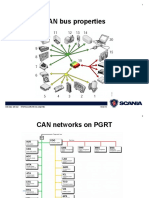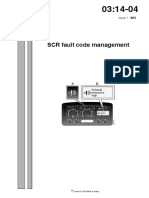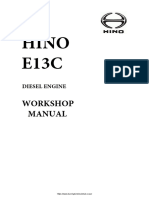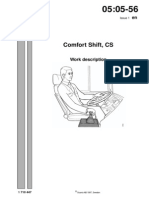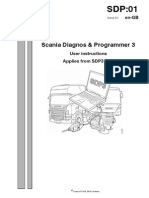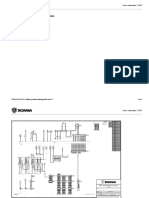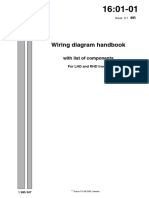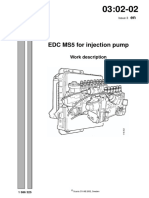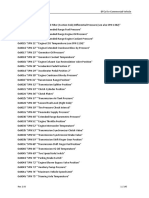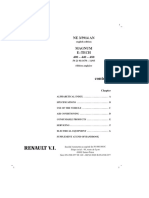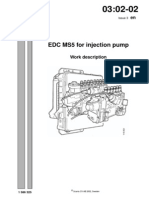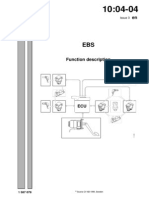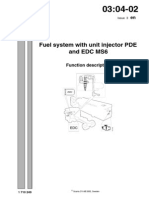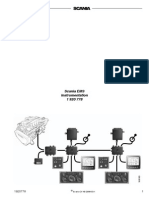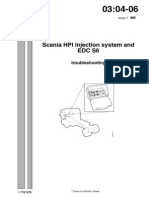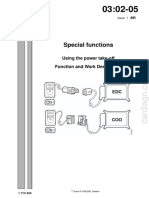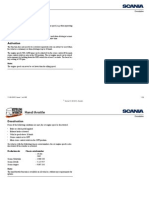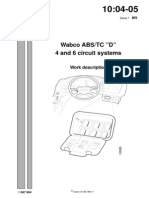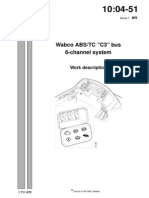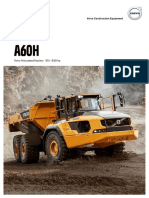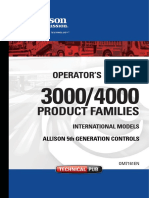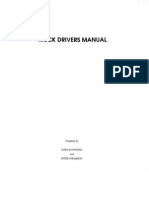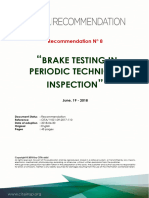en
en
Uploaded by
Registr RegistrCopyright:
Available Formats
en
en
Uploaded by
Registr RegistrOriginal Title
Copyright
Available Formats
Share this document
Did you find this document useful?
Is this content inappropriate?
Copyright:
Available Formats
en
en
Uploaded by
Registr RegistrCopyright:
Available Formats
03:02-05
Issue 1
en
Special functions
Using the power take-off Function and Work Description
1 713 434
Scania CV AB 2002, Sweden
Contents
Contents
Function description
General ..................................................................... 3 Connecting the special functions.............................. 4 Activating the special functions ............................... 5 Emergency stop ........................................................ 5 Engine speed control ................................................ 6 Torque limitation .................................................... 15 Speed limit.............................................................. 18 Connecting the special functions............................ 19 External engine control........................................... 24
Work description
Scania CV AB 2002, Sweden
03:02-05
Function description - general
Function description
General
The special functions which can be engaged and activated on the vehicle are described here. The special functions which are available are as follows:
The following limitations can be set - using Scania Programmer - for the special functions Limited hand throttle and Fixed engine speed. Limited hand throttle
Emergency stop Limited hand throttle (engine speed control mode 1) Raised idling speed (engine speed control mode 2) Fixed engine speed (engine speed control mode 3) Torque limiter 1 (provides a traditionally peaked torque curve) Torque limiter 2 (gearbox with torque converter) Torque limiter 3 (early breakaway) Speed limit 2
Maximum torque Maximum engine speed Accelerator pedal (disconnected or otherwise)
Fixed engine speed
Maximum torque (not for all MS5, introduced from 02.98) Engine speed (constant)
03:02-05
Scania CV AB 2002, Sweden
Function description - connecting the special functions
Connecting the special functions
Vehicle without coordinator
In vehicles without coordinator, the special functions are connected by earthing some of the EDC control unit pins via connector C107. The Speed limit 2 function can be connected by energising one of the EDC control unit pins with +24 V. How the different functions are connected is described in the section Work description.
Vehicle with coordinator
In vehicles with coordinator, the special functions are connected by earthing some of the coordinator pins via connector C271. The EDC control unit will then receive a CAN message from the coordinator about which function is requested. How the different functions are connected is described in the section Work description.
Scania CV AB 2002, Sweden
03:02-05
Function description - Activating the special functions
Activating the special functions
The special functions can be activated in different ways depending on the application. It can be either manually by the driver using a switch or automatically by a specific device being actuated.
Emergency stop
The emergency stop function makes it possible to stop the engine quickly in emergencies such as an accident when operating a crane. When the function Emergency stop is activated, the engine is immediately switched off if the vehicle is standing still. When driving, the throttle actuation is reduced to idling speed but the engine is not switched off. This allows the continued use of power steering for example. The function is activated by earthing a pin on connector C107 or C271. There is a stop button in the engine compartment in buses.
03:02-05
Scania CV AB 2002, Sweden
Function description - engine speed control
Engine speed control
Engine speed control is a name common to four different functions which are used to control engine speed. The functions are named as follows: Normal hand throttle, mode 0 Limited hand throttle, mode 1 Raised idling speed, mode 2 Fixed engine speed, mode 3 In normal cases, Normal hand throttle will be used. This means that the engine does not have any special engine speed restrictions. It is possible to connect an extra electrical system, so that the correct function is automatically activated when the unit for the extra system is used. If several of the functions need to be used, the pins can be earthed on the EDC control unit or coordinator in different combinations via a switch. More information about this can be found in the work description. For a description of how the engine reacts when each function is activated, see next page.
Scania CV AB 2002, Sweden
03:02-05
Function description - engine speed control
Normal hand throttle (mode 0)
The Normal hand throttle function operates so that the engine maintains the engine speed that is selected with the control for the cruise control. The function operates in a similar way to the cruise control - the difference being that Normal hand throttle regulates the engine speed rather than the vehicle speed. The engine speed can be regulated between 500 and 2000 rpm. To enable the engine to maintain the selected engine speed, the EDC control unit controls the fuel injection after first having processed signals from the engine speed sensors. In the Normal hand throttle function, the characteristics of the engine differ slightly between different engine types. Refer to Overview of engine characteristics.
This is how the normal hand throttle function is used The function is activated manually by the driver using the control for the cruise control. Preconditions
The control for the cruise control should be in the ON position. The vehicle may not be driven at a speed greater than 10 km/h.
How to set the engine speed using the control for the cruise control
Press RES, the engine will maintain the previously selected engine speed. Press ACC or RET to select a new engine speed. Then press RES for at least 3 seconds to store the engine speed.
How to change to idling speed
Press OFF or
depress the brake or clutch pedal or
activate the exhaust brake or the retarder.
03:02-05
Scania CV AB 2002, Sweden
Function description - engine speed control
Limited hand throttle (mode 1)
Using the Limited hand throttle function, it is possible to select an engine speed and an engine torque that the engine cannot exceed. The upper limits can be selected within the following ranges:
This is how the limited hand throttle function is used (mode 1) The function can be activated either manually by the driver using a switch or automatically by a specific device being actuated. Preconditions
700 - 2000 rpm minimum. 200 Nm, maximum. the maximum engine torque available
The control for the cruise control should be in the ON position. The vehicle may not be driven at a speed greater than 10 km/h.
In this way, a unit attached to the power take off can be protected from overloading for example. The function is activated by earthing a pin on connector C107 or C271. The characteristics above are set using Scania Programmer. Different engine speeds, which are below those set in Scania Programmer, can be set using the control for the cruise control. Using Scania Programmer, it is also possible to select whether or not the accelerator pedal can affect the vehicle when the Limited hand throttle is activated. In the Limited hand throttle function, the characteristics of the engine differ slightly between different engine types. Refer to Overview of engine characteristics during engine speed control.
How to set the upper limits for engine speed and engine torque
Set the upper limits for engine speed and engine torque in Scania Programmer.
How to set a new engine speed using the control for the cruise control Only engine speeds which are below the limit set using Scania Programmer, can be set.
Press RES, the engine will maintain the previously selected engine speed. First press ACC or RET to select a new engine speed. Then press RES for at least 3 seconds to store the engine speed.
IMPORTANT! By reducing the engine speed limit using the Scania Programmer and earthing the pin, the engine speed will still increase to the speed that was set previously. Therefore, before using the function, the function engagement should always be tested. Activate the function. Press ACC and then RES for three seconds to set the upper limit according to the Scania Programmer. How to change to idling speed
Press OFF or
depress the brake or clutch pedal
Scania CV AB 2002, Sweden
03:02-05
Function description - engine speed control
or
activate the exhaust brake or the retarder.
03:02-05
Scania CV AB 2002, Sweden
Function description - engine speed control
Raised idling speed (mode 2)
Using the Raised idling speed function, it is possible to select an engine speed that the engine must never be below. In this way, it is possible, for example, to fill the compressed air system or run the engine until warm. The function can also be used in vehicles equipped with a cement mixer. The function is activated by earthing a pin on connector C107 or C271. The lower engine speed limit is set with the control for the cruise control - between 500 and 800 rpm. In the Raised idling speed function, the characteristics of the engine differ slightly between different engine types. Refer to Overview of engine characteristics.
This is how the Raised idling speed function is used (mode 2) The function can be activated either manually by the driver using a switch or automatically by a specific device being actuated. How to set the desired increased idling speed using cruise control
Activate the function. The control for the cruise control must be in the ON position. Allow the vehicle to run at idling speed and set a new limit by pressing ACC or RET. Then press RES for at least 3 seconds to store the engine speed.
How to change to normal idling speed
Deactivate the function.
10
Scania CV AB 2002, Sweden
03:02-05
Function description - engine speed control
Fixed engine speed (mode 3)
The Fixed engine speed function can, using the Scania Programmer, be set with the following two limits for the engine.
This is how the Fixed engine speed function is used (mode 3) The function can be activated either manually by the driver using a switch or automatically by a specific device being actuated. Preconditions
An engine torque that the engine may not exceed. The engine torque can be regulated between 200 and the maximum engine torque. An engine speed that the engine must maintain. The engine speed can be regulated between 600 and 2000 rpm.
The vehicle may not be driven at a speed greater than 10 km/h.
How to set the engine speed and the upper limit for engine torque
The function is activated by earthing a pin on connector C107 or C271. When these functions are active, the vehicle cannot be affected by using the accelerator or the control for the cruise control. The function can be used when work requiring high precision is required. i.e. when a crane with a long reach is to be used. In the Fixed engine speed function, the characteristics of the engine differ slightly between different engine types. Refer to Overview of engine characteristics.
Set the engine speed and the upper limit for engine torque in Scania Programmer.
How to change to idling speed
Depress the brake or clutch pedal or
activate the exhaust brake or the retarder.
03:02-05
Scania CV AB 2002, Sweden
11
Function description - engine speed control
Overview of engine characteristics during engine speed control
EDC MS5 Normal hand throttle (Mode 0) Limited hand throttle (Mode 1) Raised idling speed (Mode 2) Fixed engine speed (Mode 3) A A B B
EDC MS6 (EU21) A A B B
EDC MS6 (EU32) and EDC S6 B A B A
1 = Engine types DC 1101, DC 1102, DC 1107, DSC 1203 and DSC 1205. 2 = Other engine types.
A = Rapid and more precise regulation of the engine speed. Irrespective of changes in the engine load, the engine speed will remain constant. B = Slower regulation of the engine speed. This means that changes in the engine load can lead to temporary variations in the engine speed.
12
Scania CV AB 2002, Sweden
03:02-05
Function description - engine speed control
Overview of engine speed control
Shut off criteria Mode 0 OFF >10 km/h Brake pedal Exhaust brake Retarder Clutch pedal Emergency stop function Yes Yes Yes Yes Yes Yes Yes Mode 1 Yes Yes Yes Yes Yes Yes Yes Mode 2 No No No No No No Yes Mode 3 No Yes Yes Yes Yes Yes Yes
Activation of engine speed control Mode 0 ACC, RET or RES Yes Mode 1 Yes Mode 2 No Mode 3 No
How to store an engine speed Mode 0 RES for 3 seconds Scania Programmer Engine speed range (rpm) Yes No 500 - 2000 Mode 1 Yes No 500 - 2000 Mode 2 Yes No 500 - 800 Mode 3 No Yes 600 - 2000
What can be set using the Scania Programmer Mode 0 Maximum engine speed Maximum torque No No Mode 1 Yes Yes Yes Yes Mode 2 No No No Yes Mode 3 Yes Yes No Yes
Can the accelerator pedal be used when No engine speed control is active Can the engine speed control be used Yes when a gear is engaged (only MS5 and MS6)
03:02-05
Scania CV AB 2002, Sweden
13
Function description - engine speed control
Examples of how to set three fixed engine speeds
Certain types of bodywork may require one or more pre-set fixed engine speeds. An example of how to pre-set three fixed engine speeds is shown here. Switching between them can be achieved using a switch that earths the pins. The control for cruise control must be ON before the settings can be made. Engine speed 1 Set engine speed 1 with the Raised idling speed function using the control for cruise control. Engine speed range 500 - 800 rpm Pin 5 on C107 or C271 is earthed. Engine speed 2 Set engine speed 2 with the Limited hand throttle function using the control for cruise control. Engine speed range 500 - 2000 rpm Pin 1 on C107 or C271 is earthed. Engine speed 3 Set engine speed 3 with the Fixed engine speed function. This function is programmed into the control unit using Scania Programmer. Engine speed range 600 - 2000 rpm Pins 1 and 5 on C107 or C271 are earthed.
14
Scania CV AB 2002, Sweden
03:02-05
Function description - torque limitation
Torque limitation
Torque limitation is a common term for four different functions that limit engine torque. The functions are named as follows: No torque limitation, mode 0 Torque limiter 1, mode 1 Torque limiter 2, mode 2 Torque limiter 3, mode 3 Normally it is the function No torque limitation that is used. This means that the engine does not have any special restrictions. Torque limiters 1,2 and 3 are activated by earthing a pin on connector C107 or C271. For a description of how the engine reacts when each function is activated, see next page.
03:02-05
Scania CV AB 2002, Sweden
15
Function description - torque limitation
No torque limitation (mode 0) When the No torque limitation function is connected, the engine torque curve is normal no special limits are activated.
Nm
r/min
Torque limiter 1 (mode 1) When the Torque limiter 1 function is activated, the torque curve of the engine is traditionally peaked. This torque curve may give the sensation that the pulling power increases when the engine speed decreases, i.e. on an uphill slope.
Nm
r/min
Torque limiter 2 (mode 2) The Torque limiter 2 function limits the engine torque to 700 Nm for engine speeds up to 1000 rpm. At higher engine speeds, the torque limit decreases slightly. The function is used on vehicles equipped with a torque converter with gear-changing clutch combined with a manual gearbox It should be connected so that the function is active when the clutch pedal is depressed. This function is to protect the clutch against overheating.
Nm
r/min
16
Scania CV AB 2002, Sweden
03:02-05
107 387
107 461
107 460
Function description - torque limitation
Torque limiter 3 (mode 3) The Torque limiter 3 function gives a torque curve with a so called early breakaway. The engine torque begins to decrease at 1000 rpm and disappears completely at 1400 rpm. The function can be used as an alternative to the engine speed control function Limited hand throttle if one wants to protect a power take-off for example.
Nm
r/min
Customised torque curve
The Scania Programmer can be used to program a customised torque curve. A programmed customised torque curve can be used to limit both torque and engine speed. It can be used to obtain a maximum engine speed to protect a power take-off for example. Unlike other functions, this function is not switched off when the brake or clutch pedal is depressed. The torque is set to 0 Nm to limit the engine speed. If you wish to limit the engine speed to 1000 rpm, for example, the torque is set to 0 Nm from 1000 rpm onwards. The option to program a customised torque curve has been introduced from 02.98 for MS5.
03:02-05
107 388
Scania CV AB 2002, Sweden
17
Function description - speed limit
Speed limit
It is possible to programme two different speed limits: Maximum speed and Speed limit 2. The speed limits are programmed using Scania Programmer. Below is a more detailed description of the two speed limits.
Maximum speed
The EDC control unit continuously receives information about the vehicle speed from the tachograph. When the maximum speed is reached, the control unit cuts in and limits throttle actuation so that the speed is maintained. When driving at the set maximum speed, it is possible to temporarily increase the engine speed if the clutch pedal is depressed. This function is present to facilitate downshifting while engine braking.
Speed limit 2
Speed limit 2 means that it is possible - using Scania Programmer - to pre-set a speed limit that is lower than the maximum speed. The lower speed limit can, for example, be used in refuse vehicles fitted with an external platform. Speed limit 2 can then be activated when someone is standing on the platform. The default value for Speed limit 2 is 70 km/h when a new EDC control unit is installed in a vehicle.
18
Scania CV AB 2002, Sweden
03:02-05
Work description - connecting the special functions
Work description
Connecting the special functions
Vehicle without coordinator
In trucks, the special functions are connected by earthing the pins onto connector C107 which is located below the central electric unit. C107 is connected to the EDC control unit. C107 is a blue 5-pin connector complete with both contact housings factory fitted. Voltage is supplied to one of the control unit pins for the Speed limit 2 function.
1 3
126611
Voltage is supplied to control unit pin 50 for vehicles with EDC MS5. Voltage is supplied to the control unit pins via connector C112 at the cab inlet for vehicles with EDC MS6.
+24V
C112
H6
E12
EDC
B21 B22 B19 B28 B32
B34
C107
Circuit diagram for special functions on trucks with EDC MS5. For buses - refer to wiring diagram in Workshop Manual group 16.
Circuit diagram for special functions on trucks with EDC MS6. For buses - refer to wiring diagram in Workshop Manual group 16.
03:02-05
107 521
Scania CV AB 2002, Sweden
19
Work description - connecting the special functions
Use the following parts when connecting:
Cable terminal (pin), part no. 199 950 (C107) Cable terminal (pin), part no. 815 844 (C112) Cables with cross-section 0.75 mm2
The pins and connectors to which the cables are drawn to activate each special function can be seen below.
The table applies to trucks only. Refer to the bus wiring diagram if you are connecting cables on a bus. Special function Emergency stop Limited hand throttle Raised idling speed Fixed engine speed Torque limiter 1 Torque limiter 2 Torque limiter 3 Speed limit 2 (EDC MS6) Speed limit 2 (EDC MS5) Connector pin C107, pin 2 C107, pin 1 C107, pin 5 C107, pin 1+5 C107, pin 4 C107, pin 3 C107, pin 3+4 C112, pin H-6 Control unit pin 50
20
Scania CV AB 2002, Sweden
03:02-05
Work description - connecting the special functions
Vehicle with coordinator
In trucks, the special functions are activated by earthing the pins onto connector C271 which is located in the central electric unit. C271 is connected to the Coordinator. C271 is a blue 6-pin connector complete with both contact housings factory fitted. Use the following parts when connecting:
1 2 3
4 5
126612
Cable terminal (sleeve), part no. 815 886 Cables with cross-section 0.75 mm2
03:02-05
Scania CV AB 2002, Sweden
21
Work description - connecting the special functions
The pins and connectors to which the cables are drawn to activate each special function can be seen below. The table applies to trucks only. Special function Emergency stop Limited hand throttle Raised idling speed Fixed engine speed Torque limiter 1 Torque limiter 2 Torque limiter 3 Speed limit 2 Connector pin C271, pin 2 C271, pin 1 C271, pin 5 C271, pin 1+5 C271, pin 4 C271, pin 3 C271, pin 3+4 C271, pin 6
22
Scania CV AB 2002, Sweden
03:02-05
Work description - connecting the special functions
Overview of functions
Function Emergency stop Limited hand throttle - Maximum engine speed - Maximum torque - Accelerator pedal, Active or Inactive Raised idling speed Fixed engine speed - Fixed engine speed - Maximum torque Torque limiter 1 Torque limiter 2 Torque limiter 3 Speed limit 2 * Voltage is supplied to control unit pin 50 at +24 V for vehicles with EDC MS5. Voltage is supplied to pin H6 on C112 for EDC MS6. 4 3 3+4 * 4 3 3+4 6 5 1+5 5 1+5 Yes Yes No No Yes Yes Pin on C107 2 1 Pin on C271 2 1 Yes Yes Yes No Programmed with SP No
03:02-05
Scania CV AB 2002, Sweden
23
External engine control
External engine control
In certain cases, it may be necessary to operate the engine speed control externally using controls corresponding to the cruise control ON, OFF, ACC, RET and RES. The external control is activated as shown in the wiring diagram in workshop manual 16:04-57, External engine control. IMPORTANT! The connection must be made exactly as shown in the wiring diagram. The external control should only be enabled when the parking brake is applied. The cables to the external control must also be twisted to avoid interference.
24
116 610
Scania CV AB 2002, Sweden
03:02-05
You might also like
- Can Bus ScaniaDocument21 pagesCan Bus Scaniajose breno vieira silva96% (25)
- Scania Retarder PDFDocument39 pagesScania Retarder PDFGermainCampillay67% (6)
- Renault Premium DXi 11 Service ManualDocument400 pagesRenault Premium DXi 11 Service ManualAnxo Ferreira Parada100% (3)
- Scania Xcom User GuideDocument33 pagesScania Xcom User GuideMugiraneza100% (5)
- SCR Fault Code Management: Issue 1Document18 pagesSCR Fault Code Management: Issue 1Ian100% (4)
- Hino E13c Engine Workshop Manual PDFDocument413 pagesHino E13c Engine Workshop Manual PDFmahadeo ramphal100% (18)
- enDocument67 pagesenRegistr RegistrNo ratings yet
- Scania Series 4 - Electronic Diesel Control - Edc Manual PDFDocument89 pagesScania Series 4 - Electronic Diesel Control - Edc Manual PDFChristian Ramos Campos100% (1)
- SDP 3 User ManualDocument102 pagesSDP 3 User ManualTopo Susilo100% (8)
- enDocument67 pagesenRegistr RegistrNo ratings yet
- enDocument30 pagesenRegistr Registr100% (3)
- en PDFDocument44 pagesen PDFAlex Renne Chambi100% (2)
- 16-75 BWE, Bodywork Electrical System: Overview - Sheet 1Document13 pages16-75 BWE, Bodywork Electrical System: Overview - Sheet 1lilik sukristianto100% (1)
- Motorola ScaniaDocument7 pagesMotorola Scaniabob bobkaNo ratings yet
- Trauble Shoting Elec Adt BellDocument81 pagesTrauble Shoting Elec Adt BellMoh. Zoel100% (2)
- ScaniaDocument39 pagesScaniarowan100% (7)
- 120302en PDFDocument35 pages120302en PDFduongpn100% (2)
- Wabco ABS/TC "D" 4 and 6 Channel System: Issue 3Document34 pagesWabco ABS/TC "D" 4 and 6 Channel System: Issue 3user100% (11)
- Scania Ralentizador 100507 PDFDocument39 pagesScania Ralentizador 100507 PDFGermainCampillay100% (1)
- WSM 0003232 01Document38 pagesWSM 0003232 01David Murray100% (5)
- SCANIA COO Fault Codes DTC-1Document15 pagesSCANIA COO Fault Codes DTC-1frank mutale86% (7)
- Gearbox Scania BusDocument18 pagesGearbox Scania BusNoeRtjahya Ahmad82% (11)
- Fuel System With Unit Injector PDE and EDC MS6: Issue 2Document60 pagesFuel System With Unit Injector PDE and EDC MS6: Issue 2Musharraf Khan100% (1)
- Wiring Diagram Handbook: For LHD and RHD TrucksDocument168 pagesWiring Diagram Handbook: For LHD and RHD Trucksluis meza100% (6)
- 6-Electrical System 710655Document104 pages6-Electrical System 710655Edwin Ruiz Vargas83% (36)
- WSM 0000003 01Document52 pagesWSM 0000003 01Anderson Bombista90% (10)
- EDC MS5 For Injection Pump: Issue 3Document17 pagesEDC MS5 For Injection Pump: Issue 3Miller Andres Aroca100% (1)
- Wabco ABS/TC "D" 4 and 6 Channel System: Issue 3Document34 pagesWabco ABS/TC "D" 4 and 6 Channel System: Issue 3user100% (11)
- 030203en PDFDocument57 pages030203en PDFMichael Davenport100% (1)
- DTCs For Commercial Vehicle (Rev.2.00)Document145 pagesDTCs For Commercial Vehicle (Rev.2.00)filegw gwdong100% (2)
- D NarrowDocument620 pagesD NarrowPavelNo ratings yet
- HIGER KLQ6129 Service ManualDocument24 pagesHIGER KLQ6129 Service ManualThae Ko100% (3)
- Renault Magnum 400 - 440 - 480 PDF Service Manual (PDF. ENG, 139 MB) PDFDocument251 pagesRenault Magnum 400 - 440 - 480 PDF Service Manual (PDF. ENG, 139 MB) PDFVladimir Panuch100% (7)
- Spare Parts Catalog: 6 HP 504 C Comesa-Maz Material Number: 4182.004.037 Current Date: 15.12.2010Document58 pagesSpare Parts Catalog: 6 HP 504 C Comesa-Maz Material Number: 4182.004.037 Current Date: 15.12.2010Сергей100% (1)
- enDocument84 pagesenRegistr Registr100% (11)
- enDocument17 pagesenRegistr Registr60% (5)
- enDocument40 pagesenRegistr Registr91% (11)
- enDocument44 pagesenRegistr Registr90% (10)
- Ko OrdinatorDocument31 pagesKo Ordinatoruser100% (6)
- enDocument72 pagesenRegistr Registr100% (4)
- enDocument70 pagesenRegistr Registr93% (14)
- enDocument60 pagesenRegistr Registr100% (2)
- enDocument31 pagesenRegistr Registr100% (5)
- Sistema de Combustible Con Inyector Bomba PDE y EDC S6. Descripción de FuncionamientoDocument48 pagesSistema de Combustible Con Inyector Bomba PDE y EDC S6. Descripción de FuncionamientoFelipe Sierra97% (35)
- enDocument55 pagesenRegistr Registr100% (4)
- 16 1enDocument96 pages16 1enRegistr Registr78% (9)
- Tacometro y Velocimetro ScaniaDocument48 pagesTacometro y Velocimetro ScaniaChristian Ramos Campos60% (5)
- enDocument55 pagesenRegistr Registr100% (2)
- 030402en PDFDocument55 pages030402en PDFdaniel_jorge_10No ratings yet
- enDocument83 pagesenRegistr Registr100% (13)
- Fuel System With Unit Injector PDE and EDC MS6: Issue 3Document55 pagesFuel System With Unit Injector PDE and EDC MS6: Issue 3Георгий222No ratings yet
- Electrical Components WSM 0001173 01Document53 pagesElectrical Components WSM 0001173 01ARY TOGINHO74% (31)
- 030201en PDFDocument64 pages030201en PDFMichael Davenport100% (1)
- Scania EMS 1920778Document36 pagesScania EMS 1920778Bigfair HD78100% (13)
- enDocument64 pagesenRegistr Registr100% (7)
- Damper For Range Gear Changing GR801-900, GRS890-900 Work DescriptionDocument8 pagesDamper For Range Gear Changing GR801-900, GRS890-900 Work DescriptionfugegaNo ratings yet
- Scania Dismantling ManualDocument48 pagesScania Dismantling ManualTaqi Syed93% (15)
- Electric ComponentDocument299 pagesElectric ComponentHari100% (1)
- Diag BaranDocument37 pagesDiag Baranuser100% (6)
- CAN Interface SCANIADocument80 pagesCAN Interface SCANIAManuel Solar Rigoni Dinky89% (9)
- Fuel System With Unit Injector PDE and EDC MS6: en-GBDocument54 pagesFuel System With Unit Injector PDE and EDC MS6: en-GBruan80% (5)
- ScaniaDocument111 pagesScaniasimi012392% (13)
- Scania Diagnos & Programmer 3: Issue 1Document52 pagesScania Diagnos & Programmer 3: Issue 1Luis Agustin Suaña Jala100% (2)
- B - Bledding Procedurre On Page 13Document35 pagesB - Bledding Procedurre On Page 13EndraNo ratings yet
- Munication Area Network (CAN) TerbaruDocument19 pagesMunication Area Network (CAN) TerbaruKurniawan -100% (3)
- Special Functions: Issue 1Document24 pagesSpecial Functions: Issue 1Musharraf KhanNo ratings yet
- The FAQ of Diesel EngineDocument3 pagesThe FAQ of Diesel EngineMoralxxxNo ratings yet
- Challenger7 Fly by Wire - V100Document21 pagesChallenger7 Fly by Wire - V100GustavoNo ratings yet
- Powertakeoffs GBDocument23 pagesPowertakeoffs GBAvneet MaanNo ratings yet
- Cummins QSB6.7 and QSB4.5 General Features Explaination - ElectronicsDocument9 pagesCummins QSB6.7 and QSB4.5 General Features Explaination - ElectronicsAnders HedlöfNo ratings yet
- Adjustable Parameters - EngineDocument33 pagesAdjustable Parameters - EnginescaniaNo ratings yet
- Cat Eng-Er Serv PDFDocument25 pagesCat Eng-Er Serv PDFGiapy Phuc TranNo ratings yet
- Caterpillar 3126 HEUI Engines: Mvp-Er Service ManualDocument6 pagesCaterpillar 3126 HEUI Engines: Mvp-Er Service ManualJesus Almanzar SantosNo ratings yet
- enDocument31 pagesenRegistr Registr100% (4)
- enDocument70 pagesenRegistr Registr93% (14)
- enDocument31 pagesenRegistr Registr100% (5)
- enDocument30 pagesenRegistr RegistrNo ratings yet
- enDocument83 pagesenRegistr Registr100% (13)
- enDocument72 pagesenRegistr Registr100% (4)
- enDocument21 pagesenRegistr Registr100% (1)
- enDocument60 pagesenRegistr Registr100% (3)
- enDocument55 pagesenRegistr Registr100% (4)
- enDocument64 pagesenRegistr Registr100% (7)
- enDocument60 pagesenRegistr Registr100% (2)
- enDocument70 pagesenRegistr Registr93% (14)
- enDocument55 pagesenRegistr Registr100% (2)
- enDocument24 pagesenRegistr Registr100% (6)
- 16 1enDocument96 pages16 1enRegistr Registr78% (9)
- Terex TR 45 Spec PDFDocument6 pagesTerex TR 45 Spec PDFarimbi jatisasongkoNo ratings yet
- 8.3 Description of The Hydraulic System (Face Shovel) : 8.3.1 Technical DataDocument15 pages8.3 Description of The Hydraulic System (Face Shovel) : 8.3.1 Technical DatahectorNo ratings yet
- Tr100c Parts Book CorrectDocument319 pagesTr100c Parts Book CorrectЭрхэс ЭрхэсNo ratings yet
- Brochure Volvo A60HDocument16 pagesBrochure Volvo A60HmnowaqNo ratings yet
- C0 Cat 777 DDocument6 pagesC0 Cat 777 DDeni T Kurniawan100% (2)
- Product Brochure Volvo A25G - A30GDocument24 pagesProduct Brochure Volvo A25G - A30GmnowaqNo ratings yet
- CAT 745 Automatic Retarder Control Valve - TestDocument17 pagesCAT 745 Automatic Retarder Control Valve - TestThahirullah KhalidNo ratings yet
- K360 IB 4X2 With OpticruiseDocument2 pagesK360 IB 4X2 With OpticruiseFaber KingNo ratings yet
- 735, 740 and 740E Articulated Truck Electrical SystemDocument2 pages735, 740 and 740E Articulated Truck Electrical SystemElie AbisaadNo ratings yet
- 1t36Fw6 EeyXoKnOOj2WyxsHXiHvAZPKe PDFDocument150 pages1t36Fw6 EeyXoKnOOj2WyxsHXiHvAZPKe PDFANH LÊNo ratings yet
- Truck Driver ManualDocument143 pagesTruck Driver ManualborkanserbianNo ratings yet
- 4 Cyl Cat 3406 PartsDocument286 pages4 Cyl Cat 3406 PartsJovanNo ratings yet
- HD785 7e - Cen00136 07Document16 pagesHD785 7e - Cen00136 07Faqrin Rukyat FauziNo ratings yet
- Options T880 044-19Document200 pagesOptions T880 044-19Abdelkader Draï67% (3)
- Trainer Booklet PTDocument33 pagesTrainer Booklet PTShane Lin0% (1)
- Articulated TrucksDocument41 pagesArticulated Trucksmvttma mvttmaNo ratings yet
- Peterbilt - Medium Duty Trucks - Owners ManualDocument280 pagesPeterbilt - Medium Duty Trucks - Owners ManualRolando DaclanNo ratings yet
- VCU Brochure EN 2014 FinalDocument12 pagesVCU Brochure EN 2014 Final63445 Wongsagorn100% (1)
- Air Brake SystemDocument40 pagesAir Brake Systempuspitor66No ratings yet
- Retarder 1Document2 pagesRetarder 1Patrick ByronNo ratings yet
- Operating Instructions DIWA Transmission DIWA.6, DIWA.5, DIWA.3E, DIWA.3Document40 pagesOperating Instructions DIWA Transmission DIWA.6, DIWA.5, DIWA.3E, DIWA.3Yaşar BaşerNo ratings yet
- 189 .777D Opearion and Maintenance Manual - RetardingDocument7 pages189 .777D Opearion and Maintenance Manual - Retardingzawmoe aungNo ratings yet
